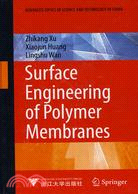商品簡介
目次
相關商品
商品簡介
Surface Engineering of Polymer Membranes covers the processes that modify membrane surfaces to improve their in-service performance,meaning, to confer surface properties which are different from the bulk properties. Purposes may be to minimize fouling, modulate hydrophilicity/hydrophobicity; enhance biocompatibility, create diffusion barriers, providefunctionalities, mimic biomembranes,fabricate nanostructures, etc. First, the basics of surface engineering of polymer membranes are covered. Then topics such as surface modification by graft polymerization and macromolecule im-mobilization, biomimetic surfaces, enzyme immobilization, molecular recognition, and nanostructured surfaces are discussed. This book provides a unique synthesis of the knowledge of the role of surface chemistry and physics in membrane science.
目次
1 Surface Engineering of Polymer Membranes: An Introduction
2 Techniques for Membrane Surface Characterization
2.1 General Principles
2.1.1 Sample Preparation
2.1.2 Where is the Surface?
2.1.3 Is it Really the Surface?
2.1.4 Invasive or Non-invasive
2.2 Chemical Composition of Membrane Surfaces
2.2.1 Attenuated Total Reflectance Fourier Transform Infrared (ATR-FTIR) Spectroscopy
2.2.2 X-ray Photoelectron Spectroscopy (XPS)
2.2.3 Static Secondary Ion Mass Spectrometry (SSIMS)
2.2.4 Energy Dispersive X-ray Spectroscopy (EDS)
2.3 Morphologies and Microstructures of Membrane. Surfaces
2.3.1 Surface Morphology of Membran
2.3.2 Introduction to Microscopy
2.3.3 Basic Conceptions in Microscopy
2.3.4 Optical Microscopy
2.3.5 Laser Confocal Scanning Microscopy (LCSM)
2.3.6 Scanning Electron Microscope
2.3.7 Environmental Scanning Electron Microscopy
2.3.8 Atomic Force Microscopy
2.4 Wettability of Membrane Surfaces
2.4.1 Wettability and Surface Properties of Membrane
2.4.2 Principle of Contact Angle
2.4.3 Methods for Contact Angle Measurement
2.4.4 Contact Angle Hysteresis
2.4.5 Factors Influencing the Contact Angle on Membrane Surfaces
2.5 Characterization of Biocompatibility of Membrane Surfaces
2.5.1 Non-specific Adsorption of Proteins
2.5.2 Interactions between Blood and Membrane
2.5.3 Interactions Between Cells and Membrane
References
3 Functionalization Methods for Membrane Surfaces
3.1 Introduction
3.2 Functionalization of Polymeric Membranes by Surface Modification
3.2.1 Coating
3.2.2 Self-assembly
3.2.3 Chemical Treatment
3.2.4 Plasma Treatment
3.2.5 Graft Polymerization
3.3 Functionalization of Polymeric Membrane by Molecular Imprinting
3.3.1 Formation of Imprinting Sites by Surface Photografting
3.3.2 Formation of Imprinting Sites by Surface Deposition
3.3.3 Formation of Imprinting Sites by Emulsion Polymerization on the Surface
3.4 Functionalization of Polymeric Membrane by Enzyme Immobilization
3.4.1 Enzyme hmnobilization by Physical Absorption
3.4.2 Enzyme Immobilization by Chemical Binding
3.4.3 Enzyme Immobilization by Entrapment
3.4.4 Other Methods for Enzyme Immobilization
3.5 Conclusion
References
4 Surface Modification by Graft Polymerization
4.1 Introduction
4.2 Graft Polymerization on Membranes
4.2.1 Surface Modification by Chemical Graft Polymerization
4.2.2 Surface Modification by Plasma-induced Graft Polymerization
4.2.3 Surface Modification by UV-induced Graft Polymerization
4.2.4 Surface Modification by High-energy Radiation- initiated Graft
4.2.5 Other Methods
4.3 Applications of Surface Modified Membranes
4.3.1 Environmental Stimuli-responsive Gating Membranes .
……
5 Surface Modification by Macromolecule Immobilization
6 Membrance with Phospholipdid Analogous Surfaces
7 Membranes with Glycosylated Surface
8 Molecularly Imprinted Membranes
9 Membrane with Biocatalytic Surface
10 Nanofibrous Membrane with Functionalized Surface
Index
2 Techniques for Membrane Surface Characterization
2.1 General Principles
2.1.1 Sample Preparation
2.1.2 Where is the Surface?
2.1.3 Is it Really the Surface?
2.1.4 Invasive or Non-invasive
2.2 Chemical Composition of Membrane Surfaces
2.2.1 Attenuated Total Reflectance Fourier Transform Infrared (ATR-FTIR) Spectroscopy
2.2.2 X-ray Photoelectron Spectroscopy (XPS)
2.2.3 Static Secondary Ion Mass Spectrometry (SSIMS)
2.2.4 Energy Dispersive X-ray Spectroscopy (EDS)
2.3 Morphologies and Microstructures of Membrane. Surfaces
2.3.1 Surface Morphology of Membran
2.3.2 Introduction to Microscopy
2.3.3 Basic Conceptions in Microscopy
2.3.4 Optical Microscopy
2.3.5 Laser Confocal Scanning Microscopy (LCSM)
2.3.6 Scanning Electron Microscope
2.3.7 Environmental Scanning Electron Microscopy
2.3.8 Atomic Force Microscopy
2.4 Wettability of Membrane Surfaces
2.4.1 Wettability and Surface Properties of Membrane
2.4.2 Principle of Contact Angle
2.4.3 Methods for Contact Angle Measurement
2.4.4 Contact Angle Hysteresis
2.4.5 Factors Influencing the Contact Angle on Membrane Surfaces
2.5 Characterization of Biocompatibility of Membrane Surfaces
2.5.1 Non-specific Adsorption of Proteins
2.5.2 Interactions between Blood and Membrane
2.5.3 Interactions Between Cells and Membrane
References
3 Functionalization Methods for Membrane Surfaces
3.1 Introduction
3.2 Functionalization of Polymeric Membranes by Surface Modification
3.2.1 Coating
3.2.2 Self-assembly
3.2.3 Chemical Treatment
3.2.4 Plasma Treatment
3.2.5 Graft Polymerization
3.3 Functionalization of Polymeric Membrane by Molecular Imprinting
3.3.1 Formation of Imprinting Sites by Surface Photografting
3.3.2 Formation of Imprinting Sites by Surface Deposition
3.3.3 Formation of Imprinting Sites by Emulsion Polymerization on the Surface
3.4 Functionalization of Polymeric Membrane by Enzyme Immobilization
3.4.1 Enzyme hmnobilization by Physical Absorption
3.4.2 Enzyme Immobilization by Chemical Binding
3.4.3 Enzyme Immobilization by Entrapment
3.4.4 Other Methods for Enzyme Immobilization
3.5 Conclusion
References
4 Surface Modification by Graft Polymerization
4.1 Introduction
4.2 Graft Polymerization on Membranes
4.2.1 Surface Modification by Chemical Graft Polymerization
4.2.2 Surface Modification by Plasma-induced Graft Polymerization
4.2.3 Surface Modification by UV-induced Graft Polymerization
4.2.4 Surface Modification by High-energy Radiation- initiated Graft
4.2.5 Other Methods
4.3 Applications of Surface Modified Membranes
4.3.1 Environmental Stimuli-responsive Gating Membranes .
……
5 Surface Modification by Macromolecule Immobilization
6 Membrance with Phospholipdid Analogous Surfaces
7 Membranes with Glycosylated Surface
8 Molecularly Imprinted Membranes
9 Membrane with Biocatalytic Surface
10 Nanofibrous Membrane with Functionalized Surface
Index
主題書展
更多
主題書展
更多書展今日66折
您曾經瀏覽過的商品
購物須知
大陸出版品因裝訂品質及貨運條件與台灣出版品落差甚大,除封面破損、內頁脫落等較嚴重的狀態,其餘商品將正常出貨。
特別提醒:部分書籍附贈之內容(如音頻mp3或影片dvd等)已無實體光碟提供,需以QR CODE 連結至當地網站註冊“並通過驗證程序”,方可下載使用。
無現貨庫存之簡體書,將向海外調貨:
海外有庫存之書籍,等候約45個工作天;
海外無庫存之書籍,平均作業時間約60個工作天,然不保證確定可調到貨,尚請見諒。
為了保護您的權益,「三民網路書店」提供會員七日商品鑑賞期(收到商品為起始日)。
若要辦理退貨,請在商品鑑賞期內寄回,且商品必須是全新狀態與完整包裝(商品、附件、發票、隨貨贈品等)否則恕不接受退貨。
























